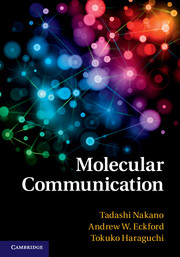Refine search
Actions for selected content:
6791 results in Communications and signal processing
4 - Introduction to quantum dynamical decoupling
- from Part I - Background
-
-
- Book:
- Quantum Error Correction
- Published online:
- 05 September 2013
- Print publication:
- 12 September 2013, pp 105-125
-
- Chapter
- Export citation
23 - Architectures
- from Part VII - Applications and implementations
-
-
- Book:
- Quantum Error Correction
- Published online:
- 05 September 2013
- Print publication:
- 12 September 2013, pp 537-552
-
- Chapter
- Export citation
Part VII - Applications and implementations
-
- Book:
- Quantum Error Correction
- Published online:
- 05 September 2013
- Print publication:
- 12 September 2013, pp 507-508
-
- Chapter
- Export citation
5 - Introduction to quantum fault tolerance
- from Part I - Background
-
-
- Book:
- Quantum Error Correction
- Published online:
- 05 September 2013
- Print publication:
- 12 September 2013, pp 126-160
-
- Chapter
- Export citation
8 - Application areas of molecular communication
-
- Book:
- Molecular Communication
- Published online:
- 05 September 2013
- Print publication:
- 12 September 2013, pp 152-168
-
- Chapter
- Export citation
Prologue
-
- Book:
- Quantum Error Correction
- Published online:
- 05 September 2013
- Print publication:
- 12 September 2013, pp xv-xviii
-
- Chapter
- Export citation
14 - High-order dynamical decoupling
- from Part IV - Advanced dynamical decoupling
-
-
- Book:
- Quantum Error Correction
- Published online:
- 05 September 2013
- Print publication:
- 12 September 2013, pp 351-375
-
- Chapter
- Export citation
9 - Quantum convolutional codes
- from Part III - Advanced quantum codes
-
-
- Book:
- Quantum Error Correction
- Published online:
- 05 September 2013
- Print publication:
- 12 September 2013, pp 231-260
-
- Chapter
- Export citation
10 - Nonadditive quantum codes
- from Part III - Advanced quantum codes
-
-
- Book:
- Quantum Error Correction
- Published online:
- 05 September 2013
- Print publication:
- 12 September 2013, pp 261-278
-
- Chapter
- Export citation
13 - Optimization-based quantum error correction
- from Part III - Advanced quantum codes
-
-
- Book:
- Quantum Error Correction
- Published online:
- 05 September 2013
- Print publication:
- 12 September 2013, pp 327-348
-
- Chapter
- Export citation
Preface and guide to the reader
-
- Book:
- Quantum Error Correction
- Published online:
- 05 September 2013
- Print publication:
- 12 September 2013, pp xix-xx
-
- Chapter
- Export citation
20 - Fault-tolerant topological cluster state quantum computing
- from Part VI - Topological methods
-
-
- Book:
- Quantum Error Correction
- Published online:
- 05 September 2013
- Print publication:
- 12 September 2013, pp 482-506
-
- Chapter
- Export citation
8 - Continuous-time quantum error correction
- from Part II - Generalized approaches to quantum error correction
-
-
- Book:
- Quantum Error Correction
- Published online:
- 05 September 2013
- Print publication:
- 12 September 2013, pp 201-228
-
- Chapter
- Export citation
17 - Fault tolerance for holonomic quantum computation
- from Part V - Alternative quantum computation approaches
-
-
- Book:
- Quantum Error Correction
- Published online:
- 05 September 2013
- Print publication:
- 12 September 2013, pp 412-431
-
- Chapter
- Export citation
Frontmatter
-
- Book:
- Bayesian Filtering and Smoothing
- Published online:
- 05 June 2014
- Print publication:
- 05 September 2013, pp i-iv
-
- Chapter
- Export citation
5 - Extended and unscented Kalman filtering
-
- Book:
- Bayesian Filtering and Smoothing
- Published online:
- 05 June 2014
- Print publication:
- 05 September 2013, pp 64-95
-
- Chapter
- Export citation

Molecular Communication
-
- Published online:
- 05 September 2013
- Print publication:
- 12 September 2013
12 - Parameter estimation
-
- Book:
- Bayesian Filtering and Smoothing
- Published online:
- 05 June 2014
- Print publication:
- 05 September 2013, pp 174-203
-
- Chapter
- Export citation

Quantum Error Correction
-
- Published online:
- 05 September 2013
- Print publication:
- 12 September 2013
1 - What are Bayesian filtering and smoothing?
-
- Book:
- Bayesian Filtering and Smoothing
- Published online:
- 05 June 2014
- Print publication:
- 05 September 2013, pp 1-16
-
- Chapter
- Export citation
